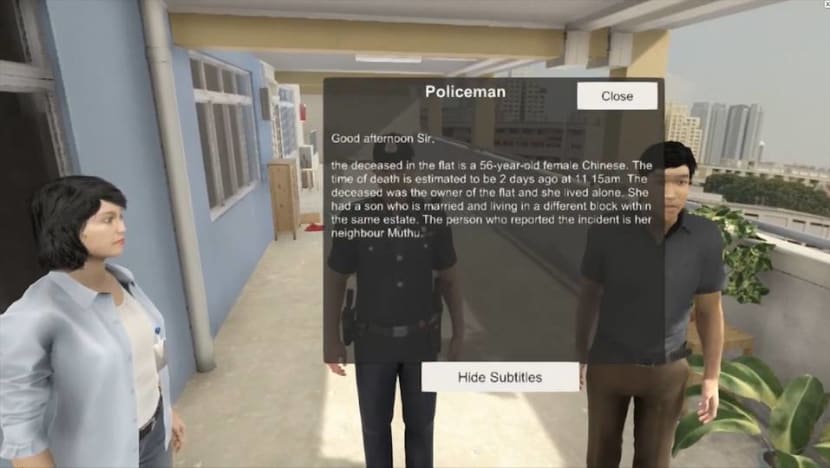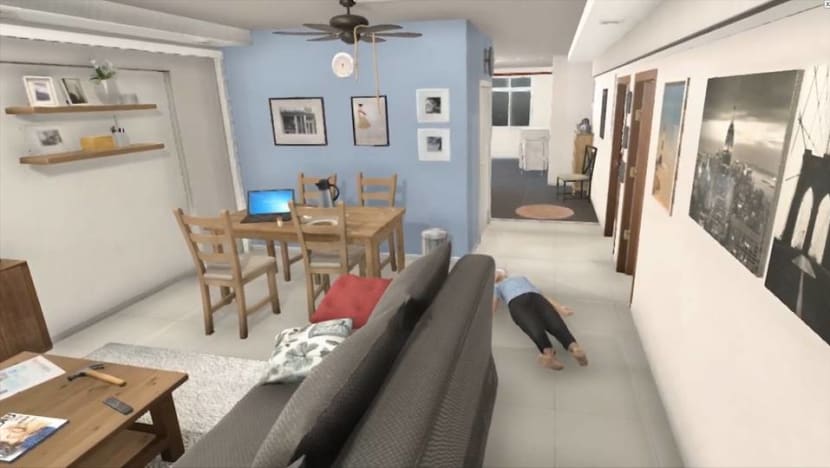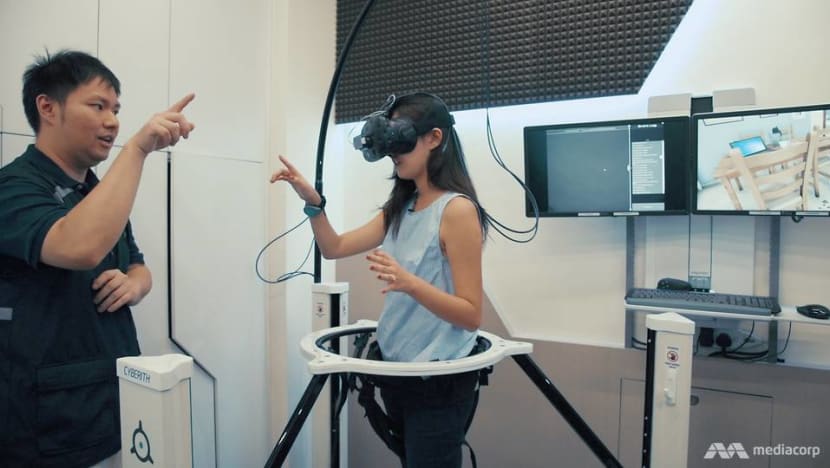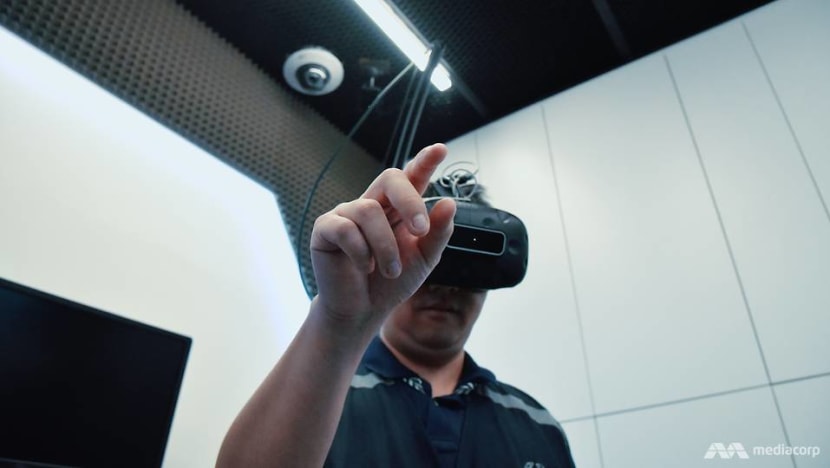‘Like being in a baby walker’: Trying out the VR technology used to train crime scene specialists
The Home Team has prototyped a training platform that uses VR technology to allow crime scene specialists to learn and practice their skills in an environment that simulates the real world. Here's what it's like to try it out.

Channel NewsAsia's Lianne Chia tries out a prototype of VR technology for crime scene specialists to learn and practice their skills. (Images: Home Team, Gaya Chandramohan)
SINGAPORE: As I lowered the VR headset over my eyes, it was as if I had stepped into the common corridor just outside a HDB flat.
The door to the flat was open and waiting for me to step in and have a look around. From the corner of my eye I could see the figure of an elderly woman lying on the floor of the living room. There were people standing around me – a policeman, a relative of the dead woman, and even a curious neighbour – ready to share their accounts of what they had seen with me.
I turned to the policeman, wondering how to initiate a conversation. Behind me, I heard a voice.
“If you want to talk to him, raise your hand and point at him. Then you need to make that pinching motion to interact with him.”
“I’M STEPPING ON THE BODY”
The experience of being in the flat was so immersive it was difficult to bring myself back to reality and listen to the directions of Senior Crime Scene Specialist Wong Jun Yan, my designated trainer.
I was being given a first-hand feel of a new platform developed by the Home Team that uses VR technology to train its crime scene specialists. Located at the Home Team Academy, the platform allows the trainees to apply the skills they learnt in the classroom in a safe and controlled training scenario – in this case, the suicide death of an elderly woman.

Jun Yan explained that prior to this, trainees would hone their skills in mock-up crime scenes, which involved a lot of preparation work on the part of the instructors.
“The instructors had to physically create the scene, place a mannequin, and after we finish, they have to wipe everything down and re-create the scene from scratch for the next person to come in,” he said. “There’s limited space and resources, and this limits the kind of scenes they can create as well.”
“VR, however, is limitless.”
He added that the richness of being immersed in the realistic virtual environment – something I also experienced when I first put the headset on – could not be compared to the mock-ups.
But despite the realism of the virtual scene I found myself in, navigating the virtual environment came with some challenges.
For one, while it was easy enough to point and pinch the objects or people I wanted to interact with, stepping into the flat and moving around was a whole different ball game.

Rather than walking normally, I was instructed to lean slightly into the harness I was strapped into, shift my centre of gravity forward, before sliding my feet back and forth to move around on the base of the platform. This, I was told, had to be done so the sensors in the base of the platform would be able to sense my movements.
I had put on special foot covers to make it easier to slide back and forth on the platform, but the movements were so counter-intuitive I had to consciously change the posture of my body and remind myself constantly not to take normal steps on the platform. My feet kept slipping off the sensors, which made it difficult to move around the flat.
And before long, a pounding headache began to set in, a sure indication of the motion sickness the trainers had warned me that first-time users tended to get.
As I turned my body, trying to get myself out of the corner of the room I had somehow managed to trap myself in, I looked down and saw the virtual body right below me.
“Uh-oh,” I said. “I think I’m stepping on the body.”
PRACTICE MAKES PERFECT
It may not have been the most successful experience in my books, but Jun Yan assured me that for a first-timer, I had done fine.
“At the beginning, I saw you struggling with the sensors, but I think it was an acclimatisation issue of walking within the system,” he said. “It’s like being in a baby walker, where you have to slide your feet across the centre.”

The trainees, he added, also need to go through a training session prior to using the platform, where they get used to the movements and controls – something I did not get the chance to experience before being strapped into the harness.
“It took me awhile to get used to sliding across the sensors rather than walking,” he said. “But once you get used to the controls, it’s quite intuitive.”
And as I saw him effortlessly navigate his way around the flat, pointing his finger to interact with objects and completing tasks like dusting for fingerprints and examining the body for ligature marks, I realised that practice really does make perfect.

The first VR training session for Home Team investigation officers was held in September 2017. The session, which runs for half a day, is open to all trainees who undergo scene of crime officer training or take a criminal investigation module. However, the system is still being fine-tuned and it will take some time for it to be rolled out to all trainees.
So far, about 240 officers in total have gone through the VR training.
Jun Yan who was among the "pioneer” batch who received the VR training said the "realism" afforded by the VR technology was invaluable and has been put to good use when he attended to a murder case.
“In the murder scene ... I had to manoeuvre a body for the pathologist and we were looking to see if there were any defensive wounds on the hands. So (the training) really helped me,” he said.
“It would have been a very big jump to using mannequins to a real body.”














